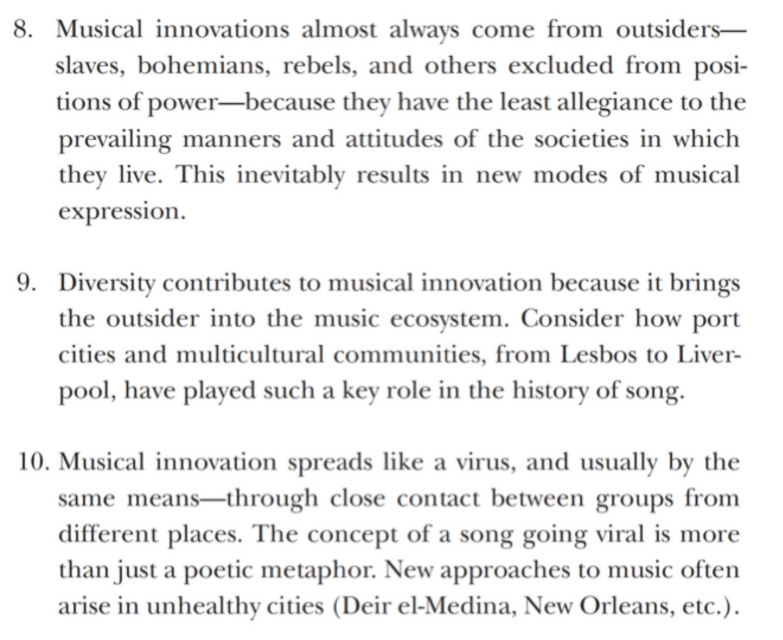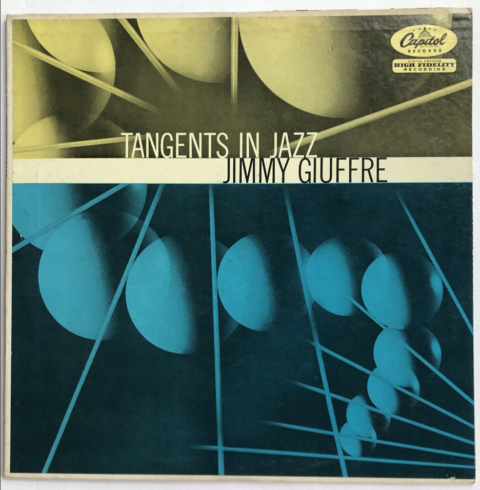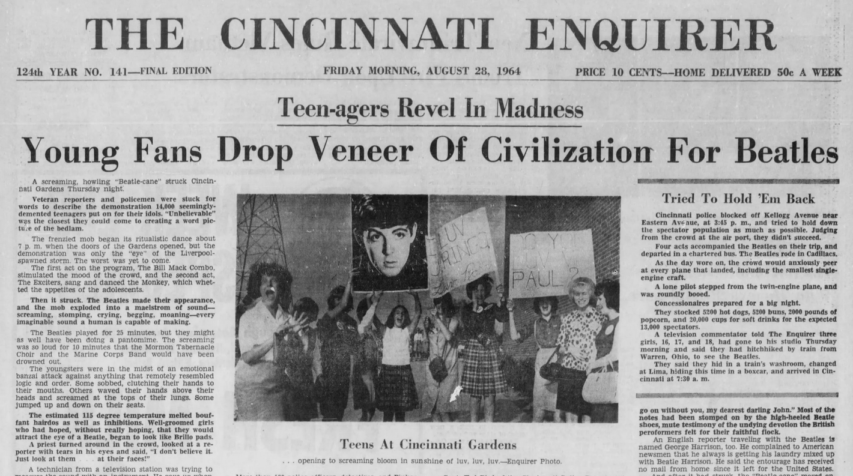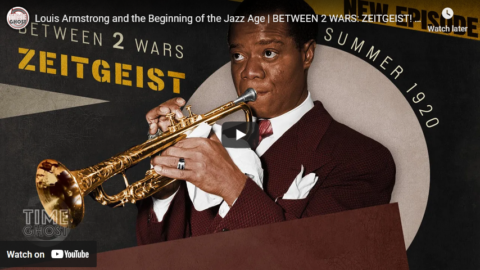In many ways, and for many people, jazz ended in the early Sixties, when Ornette Coleman, John Coltrane and Cecil Taylor suddenly became the avant-garde; in fact, almost everything that has happened to jazz in the last 50 years could be called “post-Coltrane” in much the same way that people use “postmodern”. Obviously, jazz was “free” and difficult (mad-looking Belgians with crazy hair, billowing luminescent smocks and angular, clarinet-looking instruments) or else it was nostalgic (Harry Connick Jr et al). Ironically, for a type of music so obsessed with modern and the “now”, jazz has always been preoccupied with the past, so much so that during the Eighties and Nineties it became less and less able to reflect modern culture. Everyone wanted to sound like Miles or Dizzy; either that or they went fusion mad and ended up sounding and looking like Frank Zappa on steroids.
Dylan Jones, “The 100 best jazz albums you need in your collection”, GQ, 2019-08-25.
October 15, 2023
QotD: The two eras of Jazz
September 29, 2023
QotD: Collecting jazz
So how do you build a collection? What do you do once you’ve wandered off into the jazz section. What do you buy? Not only is there just so much … stuff, but it’s an ever-expanding world. I mean, even if you knew everything there was to know about jazz, how could you possibly own it all? There are nearly as many jazz albums as there are women in the world and how could you sleep with all of them? As with any other type of music, there are some classic records you’d be mad to ignore, but with jazz you really have to plough your own furrow. The jazz police are a proscriptive lot – look to them for recommendations and they’ll tell you that Norah Jones and Stan Getz aren’t jazz, that Blue Note shouldn’t have signed St Germain and that Dave Brubeck’s “Take Five” is only ever good for paint commercials. However, these are probably the same people who, 40 years ago, would have told you that Abba don’t make good pop music or that punk was a flash in the pan.
And there were some things I just didn’t get. Ornette Coleman was one. At the same time Miles Davis was breaking through with modal jazz forms, Coleman invented free jazz with The Shape Of Jazz To Come. Over half a century after the event it is difficult to recapture the shock that greeted the arrival of this record, but it just gave me a headache. Coleman played a white plastic saxophone that looked like a toy, he dressed like a spiv and was a master of the one-liner, the “Zen Zinger” (stuff like, “When the band is playing with the drummer, it’s rock’n’roll, but when the drummer is playing with the band, it’s jazz”), so I really wanted to like his music. But I couldn’t. No matter how much I tried. As far as I was concerned he was improvising up his own sphincter.
Dylan Jones, “The 100 best jazz albums you need in your collection”, GQ, 2019-08-25.
April 27, 2023
QotD: The unexpected sources of musical innovation
First, I need to provide some background on the sources of musical innovation. Over the course of three decades of research into this matter, I kept encountering new styles of song emerging in unexpected places — but these locations always had something in common.
These epicenters of musical innovation are always densely populated cities where different cultures meet and mingle, sharing their distinctive songs and ways of life. This intermixing results in surprising hybrids — new ways of making music that nobody can foresee until it actually happens in this hothouse environment.
New Orleans provides a great example. Around the time jazz originated in New Orleans, it was the most diverse city in the world — an intense intermixing of French, Spanish, African, Caribbean, Latin American, and other cultures. And the mixture was enhanced by the huge number of travelers and traders who came to the region because of the prominence of the Mississippi River as a business and distribution hub.
Here’s how I described this process in the appendix to my book Music: A Subversive History, where I shared 40 precepts on the evolution of human songs.
I wish I had time to defend these assertions here with empirical evidence. But we don’t have the space to do that. Let me say, however, that these statements are amply documented and supported with dozens of examples and case studies in the course of that book.
Ted Gioia, “The Most Important City in the History of Music Isn’t What You Think It Is”, The Honest Broker, 2023-01-26.
April 24, 2023
Unconventional hiring practices
In The Honest Broker, Ted Gioia recounts tracking down Jazz saxophonist Jimmy Giuffre to interview him for a chapter in the book he was writing and discovering things about team-building that he hadn’t learned at Stanford Business School:
Back when I interviewed Jimmy Giuffre, I was gigging constantly and the format was obvious. The best option was piano, bass, and drum with at least one horn. If I didn’t have enough money to cover that, I brought just a trio — piano, bass, and drums — to the gig. If I couldn’t afford that, I did just piano and bass. And if cash was really tight, I opted for solo piano.
And which players did I hire?
Back then, I wanted to play with the best of the best. I kept careful tabs on all the jazz musicians in the greater San Francisco area, and wanted to play with all the top cats. Even if I didn’t know the musician, I’d make a cold call and try to hire them, provided I could afford it. If I got turned down, I went to the next name on my list.
Didn’t everybody do it that way?
Not Jimmy Giuffre. He explained that musicians played better when they were happier. Now that was a word I’d never heard in organizational theory class.
Giuffre continued to spell it out for me — surprised that I couldn’t figure this out for myself. Didn’t I know that people are always happier when they were with their friends? So group productivity is an easy problem to solve.
In other words, if my three best buddies played bongos, kazoo, and bagpipe, that should be my group.
When I heard this, I thought it made no kind of sense. They don’t call it “show friends” — they call it show business. I couldn’t imagine following Giuffre’s advice.
But over the years, I’ve thought a lot about what Jimmy Giuffre said about group formation—which is not only unusual for a music group but also violates everything I was taught back at Stanford Business School.
[…]
Can I turn this into a rule? And, even more to the point, could you apply this to other settings? Could you start a business with this approach?
That seems like a recipe for disaster, at least at first glance.
But I now think even large corporations could benefit from a dose of Jimmy Giuffre’s thinking. One of the biggest mistakes in hiring practices, as handled by HR (Human Resources) professionals in the current day is an obsession with the “required qualifications” for the job. They won’t even give you an interview unless you mention the right buzz words on your resume. But the best people take unconventional paths, and this checklist approach will exclude precisely those individuals.
(I’ve even heard of a scam for getting interviews — which involves copying and pasting the job description word-for-word at the bottom of your resume. This apparently rings all the bells in their algorithms and gets you moved to the top of the candidate list.)
Giuffre’s quirky theory gets straight to the heart of the problems with contemporary society outlined by Iain McGilchrist in his book The Master and His Emissary. That book is ostensibly a study of neuroscience, but is actually a deep-thinking critique of institutions and cultural biases. The best decisions. McGhilcrhist shows, are made by holistic thinkers who can see the big picture, but the system rewards the detail orientation of people who manage with checklists and jump through all the bureaucratic hoops.
Yet I’ve seen — and I’m sure you have too — amazing people whose skill set can’t be conveyed by their resume. Not even close. I’ve worked alongside visionaries whose education ended with high school, but have ten times the insight and ability as their colleagues with graduate degrees and fancy credentials.
That’s why Duke Ellington is such a great role model for running an organization. He hired people because of their musical character, rather than their sheer virtuosity or technical knowledge. And he certainly paid no attention to formal degrees. I wouldn’t be surprised to learn that Duke went through decades of hiring for his band without looking at a single resume.
That piece of paper wouldn’t have told him a single thing he needed to know.
For all those reasons, I no longer dismiss Jimmy Giuffre’s peculiar views on group formation. I’d recommend them myself — maybe even especially in groups where no music is made.
March 28, 2023
Miles Davis – “Concierto de Aranjuez: Adagio”
Miles Davis
Published 23 Mar 2021“Concierto de Aranjuez: Adagio” by Miles Davis
(more…)
March 26, 2023
QotD: Bing Crosby meets the modern jazz musicians
The story involves Bing Crosby in the final years of his life. He was invited to sing at an event, probably for a charity or cause, and the host enlisted some young progressive jazz musicians to accompany the famous singer. The band members weren’t impressed by this aging star, who had made his reputation back in the 1920s, and decided to throw Crosby off his game.
When Bing showed up, he greeted them in his typical laidback manner, and told them he would sing some familiar old songs. But when the performance started, these young jazz players threw in every arcane substitute chord change and rhythmic displacement they could think of, further spicing up their accompaniment with Coltrane modal fills and bits of polytonality.
Much to their frustration, nothing they did that evening disrupted Bing in the least. This old, balding pop singer navigated effortlessly through every one of their advanced harmonies, never faltering or showing the slightest degree of discomfort. Even more infuriating, Bing maintained the relaxed and unflappable delivery that was a Crosby trademark. As far as the audience could tell, he was just as happy-go-lucky as ever, and maybe he was — after all, Crosby had learned the ropes as a young man alongside Bix Beiderbecke, who was as unconventional and unpredictable as any musician from the early 20th century.
When the performance was all done, the musicians expected to get chewed out by Crosby backstage. Instead, Bing shook their hands, and thanked them with great warmth. He said how “cool it was to play with these young cats,” and expressed his sincere desire that they might do so again in the future.
Ted Gioia, “Four Perspectives on Bing Crosby”, The Honest Broker, 2022-12-23.
March 3, 2023
Miles Davis – “So What” (Official Video)
Miles Davis
Published 19 Oct 2010Official music video for “So What” by Miles Davis
Listen to Miles Davis: https://MilesDavis.lnk.to/listenYD[Come for Miles Davis, stay for the John Coltrane solo]
(more…)
February 10, 2023
Hitler’s Jazz Band – WW2 Documentary Special
World War Two
Published 9 Feb 2023Does Adolf Hitler like Duke Ellington? No, and nor do many National Socialists. But the story of the music in the Third Reich is more complicated than you might think. What if we told you that Joseph Goebbels has tried to create a Nazi-approved swing band tasked with bringing the Jazz War to the Allies?
(more…)
February 1, 2023
It’s the job of the music critic to be loudly and confidently wrong as often as possible
Ted Gioia points out that a lot of musical criticism does not pass the test of time … and sometimes it’s shown to be wrong before the ink is dry:
When I was in my twenties, I embarked on writing an in-depth history of West Coast jazz. At that juncture in my life, it was the biggest project I’d ever tackled. Just gathering the research materials took several years.
There was no Internet back then, and so I had to spend weeks and months in various libraries going through old newspapers and magazines — sometimes on microfilm (a cursed format I hope has disappeared from the face of the earth), and occasionally with physical copies.
At one juncture, I went page-by-page through hundreds of old issues of Downbeat magazine, the leading American jazz periodical founded back in 1934. And I couldn’t believe what I was reading. Again and again, the most important jazz recordings — cherished classics nowadays — were savagely attacked or smugly dismissed at the time of their initial release.
The opinions not only were wrong-headed, but they repeatedly served up exactly the opposite opinion of posterity.
Back in my twenties, I was dumbfounded by this.
I considered music critics as experts, and hoped to learn from them. But now I saw how often they got things wrong — and not just by a wee bit. They were completely off the mark.
Nowadays, this doesn’t surprise me at all. I’m painfully aware of all the compromised agendas at work in reviews — writers trying to please an editor, or impress other critics, or take a fashionable pose, or curry favor with the tenure committee, or whatever. But there is also something deeper at play in these huge historical mistakes in critical judgments, and I want to get to the bottom of it.
Let’s consider the case of the Beatles.
On the 50th anniversary of Sgt. Pepper’s Lonely Hearts Club Band, the New York Times bravely reprinted the original review that ran in the newspaper on June 18, 1967. I commend the courage of the decision-makers who were willing to make Gray Lady look so silly. But it was a wise move — if only because readers deserve a reminder of how wrong critics can be.
“Like an over-attended child, ‘Sergeant Pepper’ is spoiled,” critic Richard Goldstein announced. And he had a long list of complaints. The album was just a pastiche, and “reeks of horns and harps, harmonica quartets, assorted animal noises and a 91-piece orchestra”. He mocks the lyrics as “dismal and dull”. Above all the album fails due to an “obsession with production, coupled with a surprising shoddiness in composition”. This flaw doesn’t just destroy the occasional song, but “permeates the entire album”.
Goldstein has many other criticisms — he gripes about dissonance, reverb, echo, electronic meandering, etc. He concludes by branding the entire record as an “undistinguished collection of work”, and even attacks the famous Sgt. Pepper’s cover — lauded today as one of the most creative album designs of all time — as “busy, hip, and cluttered”.
The bottom line, according to the newspaper of record: “There is nothing beautiful on ‘Sergeant Pepper’. Nothing is real and there is nothing to get hung about.”
How could he get it so wrong?
October 5, 2022
The Amusing Inspiration Behind Dire Straits Classic 70s Hit | Professor of Rock
Professor of Rock
Published 16 Jun 2021The story of the 1979 classic “Sultans of Swing” by Dire Straits. Mark Knopfler was inspired to write the song after witnessing a band playing Dixieland Jazz in a dive bar.
Hey music junkies and vinyl junkies Professor of Rock always here to celebrate the greatest artists and the greatest 70s vinyl songs of all time for the music community and vinyl community.
If you’ve ever owned records, cassettes and CD’s at different times in you life or still do this is your place Subscribe below right now to be a part of our daily celebration of the rock era with exclusive stories from straight from the artists and click on our patreon link in the description to see our brand new show there.
Mark Knopfler was performing in London’s pub scene in the mid 70s, living on next to nothing in a flat with aspiring bassist John Illsley. Knopfler’s younger brother, David, introduced him to Illsley, following the dissolution of Mark’s first marriage. Mark, John, and David teamed up with “Pick” Withers, another London area musician, to form a group they aptly named Dire Straits.
The 4 members all had day jobs, but they lived a “hand to mouth” existence — struggling to pay their utilities bill. One rainy evening, Mark & a few friends decided to go to a nearby pub for a couple of pints in a dilapidated (dih-lap-ih-dated) section of South London. The pub was nearly empty, except for a couple of guys playing pool. In a corner of the bar, a band was playing — seemingly unaffected by the lack of an audience.
The band was “blowing Dixie — double-four time” as Knopfler would later transcribe. “Dixie double” is a performance style that was popularized by Django (jang-go) Reinhardt (rain-hart), and in the early days of Les Paul — where the guitar, bass, and drums are played harmoniously at a very fast pace.
If you’re playing “Dixie double-four time” as Knopfler describes in “Sultans of Swing”, you are playing twice the speed of the normal 4/4 time, and the drummer is working extra hard to keep up with the tempo. Knopfler remembered asking the hapless Dixie outfit to play “Creole Love Call” or “Muskrat Ramble”, much to the band’s delight, because they were undoubtedly shocked that someone in the pub actually knew some of the songs in their repertoire.
At the end of the band’s performance, the leader announced triumphantly to the 3-4 people in attendance … “We are the Sultans of Swing!”, as if they were playing in front of a packed house of ardent fans. Mark found the irony of the scene very amusing; a frumpy looking band playing a hole in the wall pub in a dodgy part of town, declaring themselves “the sultans of swing”.
To be a “sultan” would be to rule over a country, or hold a dynasty over people. The term originated from the Arabic language meaning to have “authority” or “rulership” over others. The true “Sultans of Swing” would’ve been the “swing” genre’s originator Fletcher “Smack” Henderson in the late 20s & 30s, or one of his revered disciples, Duke Ellington & Benny Goodman.
Babe Ruth and the Yankees legendary murderers row of the 20s if you’re talking baseball.
(more…)
July 15, 2021
Goodbye Lenin, Hello Jazz! | B2W:ZEITGEIST! I E.22 Winter 1924
TimeGhost History
Published 14 Jul 2021The winter of 1924 sees the death of not only Vladimir Lenin but also the Ottoman Caliphate. However, it also sees something fresh and completely unique enter the American mainstream. George Gershwin has given the Jazz Age a soundtrack.
(more…)
February 5, 2021
The 369th Infantry Regiment in WW1 – the “Harlem Hellfighters”
Lawrence W. Reed remembers the US regiment that spent the most days in combat during WW1 and was awarded the French Croix de Guerre for the unit’s incredible fighting efforts:
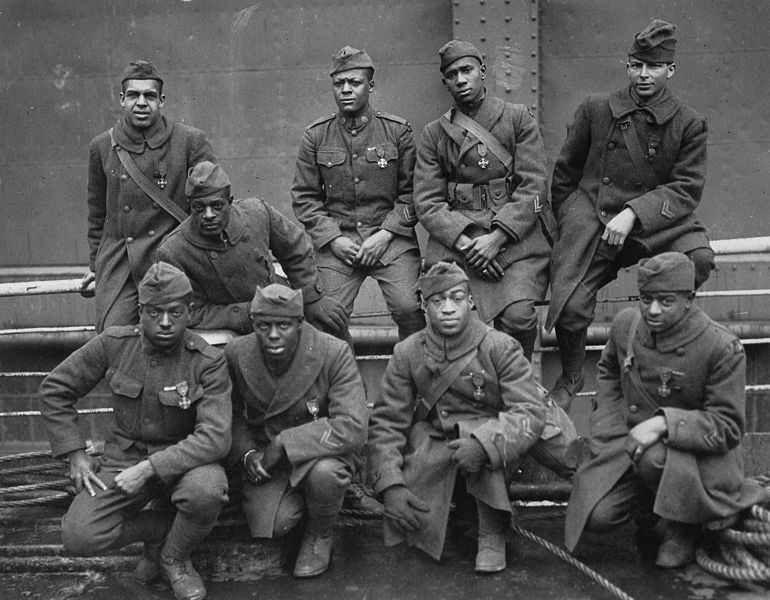
“Some of the colored men of the 369th (15th N.Y.) who won the Croix de Guerre for gallantry in action.” Left to right. Front row: Pvt. Ed Williams, Herbert Taylor, Pvt. Leon Fraitor, Pvt. Ralph Hawkins. Back Row: Sgt. H. D. Prinas, Sgt. Dan Strorms, Pvt. Joe Williams, Pvt. Alfred Hanley, and Cpl. T. W. Taylor.
Records of the War Department General and Special Staffs via Wikimedia Commons.
Formed from a New York National Guard unit, the men of the 369th learned basic military practices at Camp Whitman, New York, before being sent to Camp Wadsworth in Spartanburg, South Carolina, for combat training. They were not welcomed by many of the locals there, and some were subjected to discrimination and vile epithets for no more reason than their color. In December 1917, they were shipped to France where they expected to see action on the front lines.
Their high spirits were quickly dashed when it became apparent the Army did not want to deploy them for anything other than manual labor, far from the fighting. Even the rifles they brought with them were confiscated by US Army officials.
The commander of the American Expeditionary Force, General John J. Pershing, was reluctant to commit any US troops to the front until he felt he had assembled them in sufficient numbers to ensure victory. The French, meanwhile, were desperate for manpower. Finally bowing to French pressure, Pershing gave them the 369th. While some regarded black troops as expendable, they ultimately proved themselves indispensable.
Consider this amazing record of the Harlem Hellfighters: No American unit experienced more time in combat than they did — no less than 191 days under fire. They never lost an inch of ground. The enemy never captured a single of their number. They suffered the highest casualty rate of any US regiment. None deserted. The grateful French bestowed their highest military honor, the Croix de Guerre, upon the entire regiment. Many individuals of the regiment received the US Army’s second-highest award, the Distinguished Service Cross. Posthumously, Henry Johnson received America’s Medal of Honor in 2015. The 369th ended up as the most decorated US regiment of the war.
Another distinguishing feature of the Harlem Hellfighters was their band, the largest and best-known of any regiment. Its leader was James Reese Europe, whose enlistment in 1917 proved to be a boon for recruitment. He was one of America’s best-known black musicians and others like Noble Sissle, who became Europe’s lieutenant and lead vocalist, were eager to serve with him.
Europe’s band was extremely popular with the French, even when Europe introduced his own arrangement of La Marseillaise, France’s national anthem. The Hellfighters’ band brought both jazz and ragtime music to France, where nobody had heard either before.
December 31, 2020
Louis Armstrong and the Beginning of the Jazz Age | BETWEEN 2 WARS: ZEITGEIST! I E.08 – Summer 1920
TimeGhost History
Published 30 Dec 2020Louis Armstrong will be one of the greats of the American Century. But before that, others have to blaze a trail for him. No mean feat in a land of racial tension…
Join us on Patreon: https://www.patreon.com/TimeGhostHistory
Hosted by: Indy Neidell
Written by: Indy Neidell and Francis van Berkel
Director: Astrid Deinhard
Producers: Astrid Deinhard and Spartacus Olsson
Executive Producers: Astrid Deinhard, Indy Neidell, Spartacus Olsson, Bodo Rittenauer
Creative Producer: Maria Kyhle
Post-Production Director: Wieke Kapteijns
Research by: Indy Neidell and Francis van Berkel
Edited by: Michał Zbojna
Sound design: Marek Kamiński
Colorizations: Mikołaj Uchman and Spartacus OlssonSources:
Some images from the Library of CongressFrom the Noun Project:
world by Arafat Uddin
Stamp by Made
questions by Gregor Cresnar
Money by DARAYANI
Money Bag by HAMEL KHALED
people by Florent LenormandSoundtracks from Epidemic Sound:
“Epic Adventure Theme 3” – Håkan Eriksson
“You’re Trouble” – Rich in Rags
“1920s Chicago 2” – Magnus Ringblom
“It’s Not a Game” – Philip Ayers
“Weapon of Choice” – Fabien Tell
“On the Edge of Change” – Brightarm Orchestra
“For the Many STEMS INSTRUMENTS” – Jon Bjork
“Easy Target” – Rannar Sillard
“Step on It” – Golden Age RadioArchive by Screenocean/Reuters https://www.screenocean.com.
A TimeGhost chronological documentary produced by OnLion Entertainment GmbH.
December 21, 2020
QotD: The evolving style of John Coltrane
No jazz musician incarnates the legend of late style more than the saxophonist John Coltrane. His early style is undistinguished; he was a bluesy sideman whose grasp of the instrument falls short of the reach of his ear. His middle style, stertorous and ambitious, began in his mid-1950s stint with Miles Davis’s quintet. Coltrane in this period is still less melodious than Hank Mobley and less witty than Sonny Rollins, but his chops are catching up with his ear. Only Johnny Griffin has fleeter fingers and only Rollins can beat him for persistence. Coltrane thinks aloud and never stops thinking; he is the perfect foil for Davis, who is also ironic and intellectual, also latent with eroticism and violence, but who never shows his working, only the finished idea. Coltrane’s sound waves are square and heavy, metallic and dark like lead. He is both implacable and lazy, like a bull elephant: You never know where the charge will take him, only that — as he himself admitted to Davis — once he gets going, he doesn’t know how to stop.
Coltrane’s late style emerged in his 1960s quartets. Now leading and writing for his own group, and newly clean of drink and drugs, he was finally able to pursue his vision and the possibilities of the music to the limits of form and expression — and ultimately beyond both. The further he went, the more ambitious and less accessible the music became, until it was incomprehensible to almost all of his audience and even to some of his closest collaborators. In the logic of modernism, further means better. But “faster” and “louder” aren’t necessarily better, so why should “further” be the supreme critical value? To judge Coltrane’s late-style art is, in an important sense, to judge modernism itself, and especially American modernism.
Dominic Green, “John Coltrane and the End of Jazz”, The Weekly Standard, 2018-08-26.
December 9, 2020
QotD: The rise of bebop
The problem goes back to the early 40s, when a revolution took place in jazz. At a Harlem club named Minton’s, while the swing era was still in full bloom, a group of musicians began experimenting with a new approach to the music. Bandleader Teddy Hill formed a house band with drummer Kenny Clarke, trumpeter Dizzy Gillespie, and pianist Thelonious Monk. During nightly jam sessions others would join them, most notably sax great Charlie Parker, who had gotten his start in the swing bands of Kansas City. Vats of ink have been spilled deciphering the meaning of bebop. If jazz writers are to be believed, it defies easy categorization and requires sets and subsets to understand, but a succinct four-part summary was offered by Neil Tesser in The Playboy Guide to Jazz a couple years ago. First, the beboppers used small, quick combos — most often of trumpet and sax backed by piano, bass, and drums — instead of orchestras. Second, they used more complex chords, exploring “lively, colorful combinations of notes that previous listeners considered too dissonant for jazz.” Third, they often abandoned the melody of a song in order to improvise, relying more heavily on the song’s harmony.
Fourth, beboppers had attitude: “Instead of smooth and hummable melodies designed for dancing, the beboppers created angular tunes with unexpected accents and irregular phrases — and they expected people to listen, rather than jitterbug, to these songs and the solos that followed. The boppers emerged as jazz’s first ‘angry young men.’ They saw themselves as artists first and entertainers second, and they demanded that others respect them and their music accordingly.”
Some of the new jazz was undeniably brilliant, and many of the bebop and hard bop recordings that have been remastered and reissued only seem to acquire more appeal with age. Albums like Parker’s Now’s the Time, Art Blakey and the Jazz Messengers, Dexter Gordon’s Go, Sonny Rollins Vol. 2, and Coltrane’s Blue Train are timeless, bristling with energy, jaw-dropping improvisation, and deep spirituality. But when they cast their spell, they laid complete waste to the pop-jazz tradition. Bebop offered challenges musicians thought they could never get from traditional swing bands, as well as an improvisational ethic that provided an escape from the tough work of writing strong melodies. Some of the players saw this: In 1949 drummer Buddy Rich fired his band because his players “just want to play bop and nothing else. In fact,” Rich added, “I doubt they can play anything else.” Louis Armstrong, whose centennial is being celebrated this year, once referred to bebop as “crazy, mixed-up chords that don’t mean nothing at all.” Before long swing had become a joke. Producer Quincy Jones recalls in the documentary Listen Up that as a young musician he once hid backstage from bebop trumpeter Miles Davis so Miles wouldn’t know he was in the swinging band that had just left the stage.
Suddenly, jazz was Art. Gone were the days when 5,000 people would fill the Savoy Ballroom to lindy hop to the sunny sounds of Ella Fitzgerald or Count Basie. Bebop was impossible to dance to, which was fine with the alienated musicians in Eisenhower’s America. (You can bet this era will be well represented by beatnik [Ken] Burns [in his then-unreleased Jazz documentary TV series].) Even bebop’s own founders weren’t safe from the ideological putsch: when Bird himself made an album of pop standards with a band backed up by a string section, he was labeled a sellout. Then Elvis, to simplify matters greatly, reinvented swing for a new generation, and the Beatles arrived with sacks of great new melodies, and jazz was over as a popular music. Remarkably, beboppers and their fans still blame the drop-off on American racism. Miles once called pop music “white music,” and Kareem Abdul-Jabbar, in a documentary about the Blue Note label, offers that “whites couldn’t appreciate anything that came from black culture.” Yet whites were as responsible as blacks for making stars of Ella, Basie, and other black swing artists. Only two kinds of music were allowed on the radio following the news of FDR’s death: classical and Duke Ellington.
Mark Gauvreau Judge, “Out of Tunes”, Chicago Reader, 2000-08-31.

